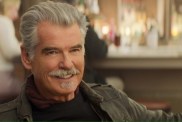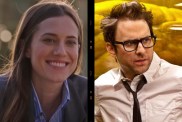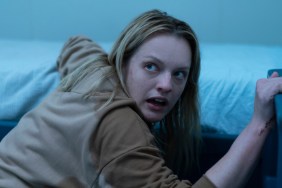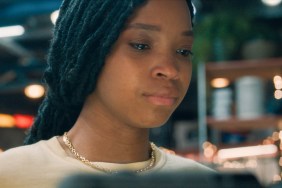Five years after the release of his Douglas Sirk pastiche Far From Heaven, indie filmmaker Todd Haynes returns to the world of music for the first time since Velvet Goldmine in 1998. This time, he’s taken on an even loftier topic, that of the musical icon Bob Dylan, exploring his life and music from his early days as a Woody Guthrie wannabe through his days toying with Hollywood and the Wild West. Because Dylan is such an enigmatic chameleon, Haynes required six actors to pull off this musical menagerie, from the youngest, Marcus Carl Franklin as young “Woody” to Richard Gere as Billy, based on Dylan’s fascination with the West, especially Billy the Kid. In between, there’s some amazing Dylan impressions (though calling them that does a disservice to their performances) from the likes of Cate Blanchett, Christian Bale, Heath Ledger and Ben Whishaw. Although this is by no means your typical, traditional biopic, because it manages to combine Haynes’ auteur tendencies with a highly entertaining overview of Dylan’s music.
When we sat down with Haynes, he was in the process of signing dozens of vinyl double albums of the just released soundtrack album, an exceptional piece of work in its own right with versions of Dylan tunes by Sonic Youth, Cat Power, Stephen Malkmus, John Doe, Calexico and many more.
ComingSoon.net: I’ve attended a few press conferences about the movie so I know the basic story behind how you got the rights to Dylan’s music, but did you have anything written at the point where you approached him?
Todd Haynes: At the point I approached Dylan? No, there was no treatment per se. But I had the characters in mind, plus this additional character Charlie at the very first incarnation that I gave to Dylan, but no, there was nothing that I was writing from when I first gave it to him, but the key characters were all in my mind.
CS: Had you done a lot of research over the years or did you just know a lot of about Dylan beforehand?
Haynes: No, no. In this renewed phase, which was all in 2000, I really didn’t even listen to Dylan that much for twenty years between high school and this period, then it all kind of came back to me. That was when I was listening to all this stuff that I had and I already knew and then it just kept kind of opening up. Little crevices would open, or doors would open, and I could enter into these much deeper avenues of material that I had never encountered before, almost all it from the past. The key things that really got my mind spinning were–and I don’t even really remember the order of them, probably the Columbia “Bootleg Series.” The first three discs was the first eye-opener and the song “She’s Your Lover Now” from the “Blonde on Blonde” period on that was just so amazing that it took me some time to even really start paying a lot of attention to disc three that had “Blind Willie McTell” and amazing stuff like that. Then I got my hands on the five discs of “The Basement Tapes,” that was astounding. Read Greil Marcus’ books about the “The Basement Tapes.” This was all 2000. Encountered the interviews from 1965 and 1966, which was just incredible, like live performance art pieces that were captured in dialogue, and then the movie “Eat the Document,” an experimental documentary that was shot in ’66. And then I read I think the Tony Scaduto biography. That was just what formed the whole concept.

CS: This was after “Velvet Goldmine” but before “Far From Heaven,” so you’d already been thinking about doing this before your last movie.
Haynes: I was writing “Far From Heaven” every night and I was doing all this stuff every day. This is when I was in Portland. I had driven across country, and it wasn’t really until I landed in Portland that I got all that material that I just described. It was all happening at the same time in this kind of very free, associative, fun way. I did get this idea for a film, but I had no serious expectations that it would ever happen because I was like, “Dylan would never give me the rights. What was I thinking?” It was just fun. It was just a pure obsessional pleasure, and interest, and then we got the rights. At this point I was settled, I wasn’t going to leave Portland. I just had fallen in love with this new place and I had lost my apartment in New York that summer and found a house that fall and I was there. Then I had to leave and do “Far From Heaven” and that basically kept me completely busy until Oscars of ’03 and that’s when I returned to Portland and really started for real. Even though I had done all that dabbling, I was like, “Well, okay, now I’m really going to start doing research in an organized way from beginning to end.”
CS: And you already had the rights to do this at that point?
Haynes: Yes, the rights happened also in that first year, in the fall of that first year in 2000. So it all happened in 2000.
CS: At that point, once you had the script, did you start to approach actors for different parts, did you have financing and how did you work on getting others on board?
Haynes: After writing the script, yeah. I finished this and we started showing a script around in 2004, but not until late in 2004. It took a year and a half to research and write the script, and then, somewhere in there, we started to approach some actors, but by ’05, we had a solid slate of actors attached to the film. We went to Cannes to try to get presales, so the actors, the leads were pretty much attached. There was one interesting switch, which was Colin Farrell was attached initially instead of Heath. I actually didn’t even know Heath’s work at that point in ’03 and ’04. Colin immediately signed on board and then it was around the time where he took a break from acting and was not reachable. And it was exactly at this point that we needed actors to sign off on contracts for the commitments that we got from Cannes, and his agent was like, “He won’t even call me back. I haven’t talked to him for two months, and he’s out of commission.” I said, “We’re going to have to go to somebody else unless you can get word to him,” and I felt really bad because he was so eager to take part initially and we couldn’t even have a discussion about it, but we had no choice. We had to be able to commit to a name for that role, for somebody for that role and that’s when I went to Heath. That pretty much completed my slate of brilliant actors.
CS: Christian I know you worked with before, but was there ever any question of which Dylan he could play? Because him and Heath and even Colin are kind of the same age range.
Haynes: You know, because of Christian’s intensity, I just saw it immediately in his face that he could convey this character of Jack Rollins. I needed somebody who you could see in a poster or in a record album and immediately accept that he had legendary status. I imagine Heath could have done something like that, but I just saw it in Christian’s face. Also, I’d seen “The Machinist” and that was so extreme and frightening, but he had hollowed out his whole face and the cheekbones were chiseled and socket of his eyes had gone dark, and I was like, “Oh my god.” One fifth of that or one tenth of that would have conveyed this kind of poetic intensity and almost severity that I kind of wanted in that Jack Rollins character. I also thought it would be really fun for Christian to have a transformation like that in the film to Pastor John and I thought that Christian was the one actor in “Velvet Goldmine” who didn’t get to sing or perform a song, that he’d get to do it in this one.
CS: That makes sense. How did you approach the actors to do it, though? Were most of them fans of Dylan anyway? I think it would be difficult to explain to premise to most people.
Haynes: I don’t know why, but I didn’t have to work on any of them. I didn’t have to convince any of them. I didn’t have to do a big song and dance. I mean, I met with Heath whom I’ve never met before, I met with Cate whom I’ve never met before, then Ben Whishaw came.

CS: I’m a big fan of his work actually. He hasn’t done much, but he’s so good in everything he does.
Haynes: He’s just so good, he’s just so preternaturally talented. He’s just incredible. He kind of introduced himself to me and then he auditioned. He put himself on tape for that role, and my jaw dropped. I felt like I was hearing the lines for the very first time, and I was just immediately listening and thinking about what he was saying, which is such a rare experience when you’re hearing it over and over. I met with Richard, but all these guys were just game, and that’s saying a lot, given the nature of the script and how dense it was.
CS: I’ve heard that Dylan hasn’t seen the movie, but were you nervous about making this film while he was still alive? Eventually, I think you’ll have to just go where he is right now with the movie, and the two of you just sit down and watch it together.
Haynes: No way, man. No way. I’ll let you do that.
CS: Well, it’s tough since you’re essentially making somewhat of a biopic about someone who’s still alive.
Haynes: Well, we kill him off in the first scene of the movie, so I thought we could clear the decks that way. No, I didn’t really think about it that much because I guess the way that I was approaching it was just not so literal obviously. It just had this different kind of emphasis. Even though I took all the periods that I was drawing from very seriously, and took the commitments Dylan made to them very seriously, and the things he said at the time very seriously, I guess I welcomed and accepted his own almost doctrine that once he’s done with something, he’s done. I think as a filmmaker, or as a creative person, that much I kind of understood. In a weird way, when you finish your film, it’s kind of not yours anymore. It’s kind of out in the world and it belongs to everybody. You have an intimacy and relationship with it like nobody else, but it just isn’t your own little thing, and yeah, I think I got that. That’s why when people say, “Why didn’t you want to sit down and talk to him?” I was like, “He’d already given me everything. What did I need to get from him in a room in a chair for half an hour?”
CS: Do you ever go back and watch some of your older movies or are you one of those people who can never see it again after working on it for so long?
Haynes: No, I can watch
it’s almost when I sort of have to, like once, I had to do a whole “Haynes on Haynes” series of interviews for a book and I was like, “Oh shit. I better watch some of them.” It wasn’t so bad. It’s fun how some of them are more fun than others to watch.
CS: What would you like people to get out of this movie whether they’re Dylan fans or not Dylan fans?
Haynes: I just want them to have a really rich experience, and an experience that is not dissimilar from a musical experience, like listening to a whole record, listening to all of “Blonde on Blonde.” Richard Gere told me that he was such a Dylan fan when he was a teenager that when he first got “Blonde on Blonde” he just lied down on the floor and put the two speakers right next to his ears and just listened to the whole record, all four sides, and that’s what I’d like people to do with the film. I’d like them to just feel like their traveling into a world and let it lead you into unexpected places. You know, these days we get a CD and we burn it into our iPod and you forget you even have it, and a song comes up three weeks later and you’re like, “Oh yeah. I never even listened to that thing all the way through.” I think we’re maybe missing something in that. I mean, I love the iPod. I love the surprise of it. I love the way it almost seems to anticipate your mood sometimes or where you are and play a string of songs. I think that’s a wild part of it, but I think that feeling of entering a space and letting the music define it is a little bit lost.

CS: I want to talk about this great soundtrack you put together–and I’m guilty as charged, since I’ve had the “Velvet Goldmine” soundtrack on my iPod for years. At what point did you start deciding which group would do which song and getting the bands involved? Obviously, Cate and Christian had to perform to their respective songs.
Haynes: As you point out, all the ones that had to be filmed and put together in advance were the first ones on our agenda to try to figure out, but all of the decisions of what the songs were was part of the script writing process long before. As you can see, a lot of the scenes are completely built around them, even if it’s not as literal as in “Ballad of a Thin Man,” it definitely is true for the spirit or the mood of the way the storytelling works, the way the songs as they are chosen. Only one sort of important decision of a song that was going to fuel one of the scenes changed in editing and that was from “Wheels on Fire,” which is a fantastic song, was supposed to be in the scene where Cate was typewriting with the tarantula, but it didn’t have the right tension somehow. That song is a kind of stately tension, a kind of stately, kind of gothic doom to it, and I had encountered this amazing “Iggy and the Stooges” version of that song from their rehearsal sessions in 1973 and its just a early drum machine going, “Ch Ch Ch Ch Ch” and Ron Ashton on guitar. It’s a twelve-minute long version of “Ballad of Hollis Brown” and it just blew my mind. We tried it one night and it was just like, “Oh my God!” That scene came alive and that was one of the few real changes of plan, but yeah, I worked with Randy Poster, as I did on “Velvet Goldmine,” and it was in close consultation with him that the actual artists were selected.
CS: What was the significance of the extended harmonica solo that ends the movie?
Haynes: That was something I saw in “Eat the Document,” being that film I described, and that’s what the clip is from. But it’s Dylan on stage performing in 1966, and actually nobody in the annals of all of the Dylanists on the internet and everywhere else, and even Jeff Rosen, can tell us where he was for that one harmonica solo which was filmed by Pennebaker, but it’s to “Mr. Tambourine Man.” I just found it to be beautifully un-resolving and just circular that it just keeps going on and on.
CS: What’s going on with the theatrical version of this? I know that was part of your original commission when you got the rights. Would it be the same concept with six different actors playing the different Dylan personas.
Haynes: Oh yeah. That was the whole point which was to use the same whole multiple character concept for the stage, and I only really took it on because I sort of thought, “Wow, there’s something that could actually happen on a stage with the characters all even sharing a single space or even sharing a song, that you couldn’t do in a film. Except the way they do it in “West Side Story.” (Starts to sing a few bars from “Tonight.”)
CS: We’re going to have to put that on the site as audio. Is that musical something you’re still going to be involved in?
Haynes: No, no, no that went away. That became I believe the Twyla Tharp thing that Dylan did get involved in. I’m glad we’re talking about it because Jeff Rosen brought it up to me, and that’s when I first brought Oren Moverman into the process, was to help me write the theatrical version. I was going to do the script and he was going to do the theatrical version, and then it kind of dissipated, we never really heard anything about Jeff, and then all of a sudden we were hearing rumors about Twyla Tharp and we were like, “Oh. Oh, okay.”
I’m Not There opens in select cities on Wednesday, November 21.









